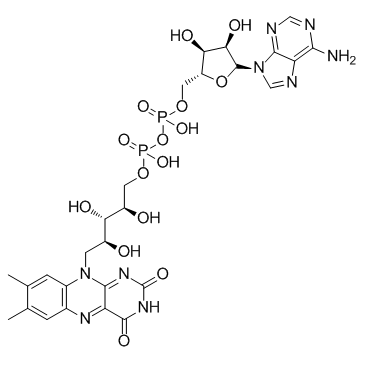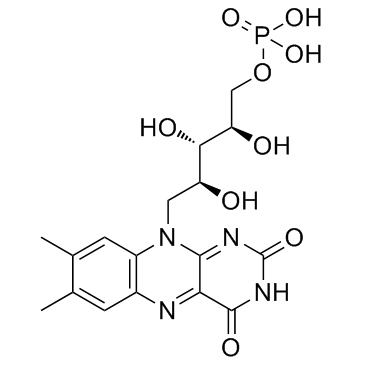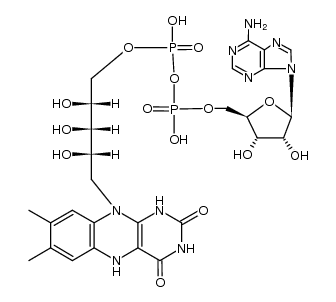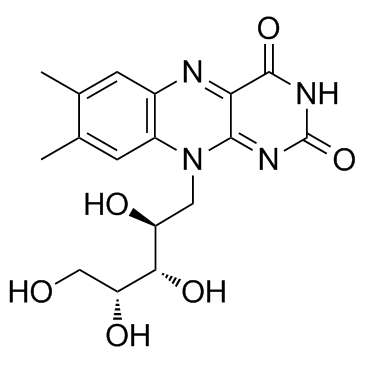146-14-5
| 中文名 | 腺嘌呤黄素 |
|---|---|
| 英文名 | fad |
| 中文别名 |
核黄素-5'-腺苷二磷酸,RIBOFLAVIN-5'-ADENOSINE-DIPHOSPHATE
黄素腺嘌呤二核苷酸 |
| 英文别名 |
Adenosine 5'-(Trihydrogen Diphosphate) 5'®5'-Ester With Riboflavine
Riboflavine 5'-(Trihydrogen Diphosphate) 5'®5'-Ester with Adenosine Riboflavine 5'-Adenosine Diphosphate Flavin adenin dinucleotide FLAVIN ADENINE DINUCLEOTIDE [(2R,3S,4R,5R)-5-(6-Amino-9H-purin-9-yl)-3,4-dihydroxytetrahydro-2-furanyl]methyl (2R,3S,4S)-5-(7,8-dimethyl-2,4-dioxo-3,4-dihydrobenzo[g]pteridin-10(2H)-yl)-2,3,4-trihydroxypentyl dihydrogen diphosphate (non-preferred name) Flavine Adenine 1H-Purin-6-amine Flavin Dinucleotide EINECS 282-733-8 Riboflavine 5'-Ester with Adenosine 5'-Diphosphate [(2R,3S,4R,5R)-5-(6-Amino-9H-purin-9-yl)-3,4-dihydroxytetrahydrofuran-2-yl]methyl (2R,3S,4S)-5-(7,8-dimethyl-2,4-dioxo-3,4-dihydrobenzo[g]pteridin-10(2H)-yl)-2,3,4-trihydroxypentyl dihydrogen diphosphate (non-preferred name) [(2R,3S,4R,5R)-5-(6-Amino-9H-purin-9-yl)-3,4-dihydroxytetrahydro-2-furanyl]methyl (2R,3S,4S)-5-(7,8-dimethyl-2,4-dioxo-3,4-dihydrobenzo[g]pteridin-10(2H)-yl)-2,3,4-trihydroxypentyl dihydrogen diphosphate |
| 描述 | Flavin Adenin Dinucleotide 是一种氧化还原辅因子,蛋白质的辅基,在代谢过程中参与了几个重要的酶反应。 |
|---|---|
| 相关类别 | |
| 靶点 |
Human Endogenous Metabolite |
| 体外研究 | 聚(黄素腺嘌呤二核苷酸,FAD)的特点是额外的聚合物型氧化还原反应是一种非常有效的NADH氧化电催化剂:在NADH传感器报道的最低电位(0.00 V,pH 7.4),聚(FAD)的特点是电化学速率常数为1.8±0.6×10-3 cm/s,处于NADH传质常数的水平。 Poly(FAD)修饰电极的特点是稳定性显着提高,是分析化学中最有利的NADH传感器[2]。 |
| 体内研究 | 黄素腺嘌呤二核苷酸(2 mg/kg,iv)显着抵消了氯丙嗪(CPZ)诱导的心室颤动阈值(VFT)降低。 Flavin Adenin Dinucleotide消除了CPZ对犬心脏线粒体的影响。注射黄素腺嘌呤二核苷酸后,狗在10分钟内出现短暂的低血压,然后他们的血压恢复到初始水平。 Flavin Adenin二核苷酸还可以预防氯丙嗪诱导的线粒体功能障碍[1]。 |
| 动物实验 | 狗[1]将狗分为3组,并接受以下治疗。每组由6只狗组成。组I中的狗作为对照,通过静脉内注射给予2mL / kg生理盐水。在第一次注射开始后10分钟,静脉注射另一剂盐水,1mL / kg。第II组中的狗静脉注射2mL盐水/ kg。 10分钟后,注射1mg氯丙嗪(CPZ)/ kg。组III中的狗给予静脉黄素腺嘌呤二核苷酸,2mg / kg。 10分钟后,他们给予CPZ,1毫克/千克。所有溶液在1分钟或2分钟内给药。在静脉内注射盐水(组I和II)或黄素腺嘌呤二核苷酸组(组III)之前和10,20,30和40分钟时采集血液样品。还测量血清K +和血液pH。每只狗的心率,血压和心室颤动阈值(VFT)以相同的间隔记录[1]。 |
| 参考文献 |
| 密度 | 2.1±0.1 g/cm3 |
|---|---|
| 分子式 | C27H33N9O15P2 |
| 分子量 | 785.550 |
| 精确质量 | 785.157104 |
| PSA | 382.55000 |
| LogP | -2.93 |
| 外观性状 | 固体 |
| 折射率 | 1.850 |
| 储存条件 | -20 ºC条件下保存。 |
| 稳定性 | 常温常压下稳定。 |
| 分子结构 | 五、分子性质数据: 1、 摩尔折射率:168.11 2、 摩尔体积(cm3/mol):376.2 3、 等张比容(90.2K):1230.5 4、 表面张力(dyne/cm):114.4 5、 极化率(10-24cm3):66.64 |
| 计算化学 | 四、计算化学数据: 1、 疏水参数计算参考值(XlogP):-5 2、 氢键供体数量:9 3、 氢键受体数量:21 4、 可旋转化学键数量:13 5、 拓扑分子极性表面积(TPSA):356 6、 重原子数量:53 7、 表面电荷:0 8、 复杂度:1560 9、 同位素原子数量:0 10、 确定原子立构中心数量:7 11、 不确定原子立构中心数量:0 12、 确定化学键立构中心数量:0 13、 不确定化学键立构中心数量:0 14、 共价键单元数量:1 |
| 更多 | 一、物性数据: 1. 性状:橙黄色粉末 2. 溶解性:易溶于水,不溶于乙醇,水溶液呈黄绿色荧光,遇碱分解为核黄素。 |
Synonym: Adenine-riboflavin dinucleotide; Flavine Adenosine Diphosphate; Isoalloxazine-adenine dinucleotide; FAD. SECTION 2 - COMPOSITION, INFORMATION ON INGREDIENTS
Risk Phrases: None Listed. SECTION 3 - HAZARDS IDENTIFICATION EMERGENCY OVERVIEW The toxicological properties of this material have not been fully investigated. Potential Health Effects Eye: May cause eye irritation. Skin: May cause skin irritation.
Ingestion: May cause irritation of the digestive tract. The toxicological properties of this substance have not been fully investigated. Inhalation: May cause respiratory tract irritation. The toxicological properties of this substance have not been fully investigated. Chronic: No information found. SECTION 4 - FIRST AID MEASURES Eyes: Flush eyes with plenty of water for at least 15 minutes, occasionally lifting the upper and lower eyelids. Get medical aid immediately. Skin: Get medical aid. Flush skin with plenty of water for at least 15 minutes while removing contaminated clothing and shoes. Wash clothing before reuse. Ingestion: If victim is conscious and alert, give 2-4 cupfuls of milk or water. Never give anything by mouth to an unconscious person. Get medical aid immediately. Inhalation: Remove from exposure and move to fresh air immediately. If not breathing, give artificial respiration. If breathing is difficult, give oxygen. Get medical aid. Notes to Physician: Antidote: None reported. SECTION 5 - FIRE FIGHTING MEASURES General Information: As in any fire, wear a self-contained breathing apparatus in pressure-demand, MSHA/NIOSH (approved or equivalent), and full protective gear. During a fire, irritating and highly toxic gases may be generated by thermal decomposition or combustion. Extinguishing Media: Use water spray, dry chemical, carbon dioxide, or appropriate foam. SECTION 6 - ACCIDENTAL RELEASE MEASURES General Information: Use proper personal protective equipment as indicated in Section 8. Spills/Leaks: Clean up spills immediately, observing precautions in the Protective Equipment section. Sweep up or absorb material, then place into a suitable clean, dry, closed container for disposal. Avoid generating dusty conditions. Provide ventilation. SECTION 7 - HANDLING and STORAGE Handling: Wash thoroughly after handling. Remove contaminated clothing and wash before reuse. Use with adequate ventilation. Minimize dust generation and accumulation. Avoid contact with eyes, skin, and clothing. Keep container tightly closed. Avoid ingestion and inhalation. Storage: Keep container closed when not in use. Store in a tightly closed container. Store in a cool, dry, well-ventilated area away from incompatible substances. SECTION 8 - EXPOSURE CONTROLS, PERSONAL PROTECTION Engineering Controls: Use adequate ventilation to keep airborne concentrations low. Exposure Limits CAS# 146-14-5: Personal Protective Equipment Eyes: Wear appropriate protective eyeglasses or chemical safety goggles as described by OSHA's eye and face protection regulations in 29 CFR 1910.133 or European Standard EN166. Skin: Wear appropriate protective gloves to prevent skin exposure. Clothing: Wear appropriate protective clothing to prevent skin exposure. Respirators: Follow the OSHA respirator regulations found in 29 CFR 1910.134 or European Standard EN 149. Use a NIOSH/MSHA or European Standard EN 149 approved respirator if exposure limits are exceeded or if irritation or other symptoms are experienced. SECTION 9 - PHYSICAL AND CHEMICAL PROPERTIES Physical State: Solid Color: Not available. Odor: Not available. pH: Not available. Vapor Pressure: Not available. Viscosity: Not available. Boiling Point: Not available. Freezing/Melting Point: Not available. Autoignition Temperature: Not available. Flash Point: Not available. Explosion Limits, lower: N/A Explosion Limits, upper: N/A Decomposition Temperature: Solubility in water: Specific Gravity/Density: Molecular Formula: C27H31N9Na2O15P2 Molecular Weight: 829.1955 SECTION 10 - STABILITY AND REACTIVITY Chemical Stability: Stable under normal temperatures and pressures. Conditions to Avoid: Incompatible materials, dust generation, strong oxidants. Incompatibilities with Other Materials: None reported. Hazardous Decomposition Products: Carbon monoxide, oxides of nitrogen, oxides of phosphorus, irritating and toxic fumes and gases, carbon dioxide. Hazardous Polymerization: Will not occur. SECTION 11 - TOXICOLOGICAL INFORMATION RTECS#: CAS# 146-14-5: AU7470000 LD50/LC50: CAS# 146-14-5: Oral, mouse: LD50 = >7 gm/kg. Carcinogenicity: Flavine-adenine dinucleotide - Not listed by ACGIH, IARC, or NTP. Other: See actual entry in RTECS for complete information. SECTION 12 - ECOLOGICAL INFORMATION Other No information available. SECTION 13 - DISPOSAL CONSIDERATIONS Dispose of in a manner consistent with federal, state, and local regulations. SECTION 14 - TRANSPORT INFORMATION IATA Not regulated as a hazardous material. IMO Not regulated as a hazardous material. RID/ADR Not regulated as a hazardous material. SECTION 15 - REGULATORY INFORMATION European/International Regulations European Labeling in Accordance with EC Directives Hazard Symbols: Not available. Risk Phrases: Safety Phrases: S 24/25 Avoid contact with skin and eyes. S 28A After contact with skin, wash immediately with plenty of water. S 37 Wear suitable gloves. S 45 In case of accident or if you feel unwell, seek medical advice immediately (show the label where possible). WGK (Water Danger/Protection) CAS# 146-14-5: No information available. Canada CAS# 146-14-5 is listed on Canada's NDSL List. CAS# 146-14-5 is not listed on Canada's Ingredient Disclosure List. US FEDERAL TSCA CAS# 146-14-5 is listed on the TSCA inventory. SECTION 16 - ADDITIONAL INFORMATION MSDS Creation Date: 1/06/1999 Revision #2 Date: 3/18/2003 The information above is believed to be accurate and represents the best information currently available to us. However, we make no warranty of merchantability or any other warranty, express or implied, with respect to such information, and we assume no liability resulting from its use. Users should make their own investigations to determine the suitability of the information for their particular purposes. In no way shall the company be liable for any claims, losses, or damages of any third party or for lost profits or any special, indirect, incidental, consequential or exemplary damages, howsoever arising, even if the company has been advised of the possibility of such damages. SECTION 16 - ADDITIONAL INFORMATION N/A |
|
毒理学数据: 二、毒理学数据: 1、急性毒性: 小鼠经口LC50:>7 gm/kg; 小鼠静脉LC50:589 mg/kg. 生态学数据: 三、生态学数据: 通常对水是不危害的,若无政府许可,勿将材料排入周围环境。 CHEMICAL IDENTIFICATION
HEALTH HAZARD DATAACUTE TOXICITY DATA
|
| 安全声明 (欧洲) | 24/25 |
|---|---|
| WGK德国 | 3 |
| RTECS号 | AU7470000 |
| 海关编码 | 29349990 |
|
~% 
146-14-5 |
| 文献:Journal of the American Chemical Society, , vol. 77, p. 6716 |
|
~% 
146-14-5 |
| 文献:Journal of Biological Chemistry, , vol. 182, p. 795,799 |
|
~% 
146-14-5 |
| 文献:ChemMedChem, , vol. 6, # 2 p. 279 - 291 |








![Benzo[g]pteridine-10 (2H)-acetaldehyde, 3,4-dihydro-7,8-dimethyl-2, 4-dioxo结构式](https://image.chemsrc.com/caspic/160/4250-90-2.png)